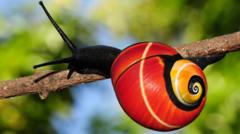In a crucial conservation effort, researchers are trying to save the world's most beautiful snails—the colorful Polymita tree snails found in Eastern Cuba. These snails, with their vibrant shells, are increasingly threatened by collectors, pushing them closer to extinction.
The most endangered species, Polymita sulphurosa, boasts lime green and blue flame patterns, yet it, along with its relatives, is at risk because its beauty attracts collectors seeking to cash in on their shells. Professor Angus Davison from the University of Nottingham points out the irony: "Their beauty is the reason they're endangered."
While international laws exist to protect the Polymita snails, the enforcement of these regulations proves difficult. It’s illegal to export them or their shells from Cuba without a permit, but legal sales persist elsewhere. "With climate change and habitat loss, shell collecting could lead to their local extinction," warns Prof. Davison.
To combat this, Prof. Davison collaborates with Cuban conservation biologist Prof. Bernardo Reyes-Tur. Reyes-Tur is working under challenging conditions, as he tries to breed these snails at home amid unreliable power supplies. Meanwhile, researchers in Nottingham are conducting vital genetic studies to understand the number of Polymita species and uncover the genes responsible for their unique colors.
Together, they hope to harness this genetic knowledge to bolster conservation efforts before these breathtaking creatures vanish from our planet forever. "Eastern Cuba is their only home, and we must use our findings to aid their survival," said Prof. Davison.






















